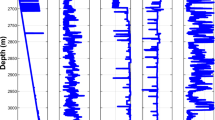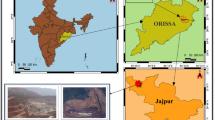Abstract
Dam behavior prediction model is a fundamental component of dam structural health monitoring systems. As the most intuitive monitoring indicators, deformation is commonly used to reflect the dam behavior change. The selection of input variables and training samples determines the performance of dam deformation predictive models. In this paper, a novel hybrid model integrating principal component analysis (PCA), fuzzy C-means (FCM), and Gaussian process regression (GPR) are proposed to predict dam deformation. Specifically, PCA is utilized to extract the main information of original thermometer data as temperature variables, while FCM is used to divide the samples into several categories according to the similarity of the environmental monitoring data. Then, the samples in each category are used to train GPR models with five commonly used covariance functions based on influencing factors, respectively. In the test phase, FCM is used to determine what category the samples in the test set belong to, and then, the corresponding trained GPR model is utilized to predict dam deformation. The proposed hybrid model is fully demonstrated and validated by monitoring data collected from a multiple-arch concrete dam in long-term service. Various benchmark models with or without FCM analysis are selected as comparison models. Experimental results show the proposed novel model outperforms the other comparison methods in terms of all evaluation indicators. This indicates fuzzy clustering analysis can effectively improve the performance of the prediction model, and the proposed hybrid model can predict future dam deformation with high accuracy and efficiency.











Similar content being viewed by others
Data Availability
The data used to support the findings of this study are included within the supplementary information file(s).
References
Dai, B.; Gu, C.; Zhao, E.; Qin, X.: Statistical model optimized random forest regression model for concrete dam deformation monitoring. Struct. Control Heal. Monit. 25, 1–15 (2018). https://doi.org/10.1002/stc.2170
Yang, L.; Su, H.; Wen, Z.: Improved PLS and PSO methods-based back analysis for elastic modulus of dam. Adv. Eng. Softw. 131, 205–216 (2019). https://doi.org/10.1016/j.advengsoft.2019.02.005
Chen, B.; Gu, C.; Bao, T.; Wu, B.; Su, H.: Failure analysis method of concrete arch dam based on elastic strain energy criterion. Eng. Fail. Anal. 60, 363–373 (2016). https://doi.org/10.1016/j.engfailanal.2015.11.045
Li, Y.; Bao, T.; Gong, J.; Shu, X.; Zhang, K.: The prediction of dam displacement time series using STL, extra-trees, and stacked LSTM neural network. IEEE Access 8, 94440–94452 (2020). https://doi.org/10.1109/ACCESS.2020.2995592
Salazar, F.; Morán, R.; Toledo, M.; Oñate, E.: Data-based models for the prediction of dam behaviour: a review and some methodological considerations. Arch. Comput. Methods Eng. 24, 1–21 (2017). https://doi.org/10.1007/s11831-015-9157-9
Chen, B.; Wu, Z.; Liang, J.; Dou, Y.: Time-varying identification model for crack monitoring data from concrete dams based on support vector regression and the Bayesian framework. Math. Probl. Eng. (2017). https://doi.org/10.1155/2017/5450297
Mata, J.: Interpretation of concrete dam behaviour with artificial neural network and multiple linear regression models. Eng. Struct. 33, 903–910 (2011). https://doi.org/10.1016/j.engstruct.2010.12.011
Salazar, F.; Toledo, M.A.; Oñate, E.; Morán, R.: An empirical comparison of machine learning techniques for dam behaviour modelling. Struct. Saf. 56, 9–17 (2015). https://doi.org/10.1016/j.strusafe.2015.05.001
Kong, D.; Chen, Y.; Li, N.: Gaussian process regression for tool wear prediction. Mech. Syst. Signal Process. 104, 556–574 (2018). https://doi.org/10.1016/j.ymssp.2017.11.021
Chen, Z.; Wang, B.; Gorban, A.N.: Multivariate Gaussian and Student-t process regression for multi-output prediction. Neural Comput. Appl. (2019). https://doi.org/10.1007/s00521-019-04687-8
Chen, Z.: Gaussian process regression methods and extensions for stock market prediction. University of Leicester (2017)
Lin, C.; Li, T.; Chen, S.; Liu, X.; Lin, C.; Liang, S.: Gaussian process regression-based forecasting model of dam deformation. Neural Comput. Appl. 31, 8503–8518 (2019). https://doi.org/10.1007/s00521-019-04375-7
Roushangar, K.; Garekhani, S.; Alizadeh, F.: Forecasting daily seepage discharge of an earth dam using wavelet-mutual information—Gaussian process regression approaches. Geotech. Geol. Eng. 34, 1313–1326 (2016). https://doi.org/10.1007/s10706-016-0044-4
Qin, X.; Gu, C.; Zhao, E.; Chen, B.; Yu, Y.; Dai, B.: Monitoring indexes of concrete dam based on correlation and discreteness of multi-point displacements. PLoS ONE 13, 1–16 (2018). https://doi.org/10.1371/journal.pone.0200679
Javadi, S.; Rameez, M.; Dahl, M.; Pettersson, M.I.: Vehicle classification based on multiple fuzzy c-means clustering using dimensions and speed features. Procedia Comput. Sci. 126, 1344–1350 (2018). https://doi.org/10.1016/j.procS.2018.08.085
Yu, H.; Wu, Z.R.; Bao, T.F.; Zhang, L.: Multivariate analysis in dam monitoring data with PCA. Sci. China Technol. Sci. 53, 1088–1097 (2010). https://doi.org/10.1007/s11431-010-0060-1
Chen, B.; Hu, T.; Huang, Z.; Fang, C.: A spatio-temporal clustering and diagnosis method for concrete arch dams using deformation monitoring data. Struct. Heal. Monit. (2018). https://doi.org/10.1177/1475921718797949
Chen, S.; Gu, C.; Lin, C.; Zhao, E.; Song, J.: Safety monitoring model of a super-high concrete dam by using RBF neural network coupled with kernel principal component analysis. Math. Probl. Eng. (2018). https://doi.org/10.1155/2018/1712653
Wold, S.; Esbensen, K.; Geladi, P.: A pedagogy of charity: Donald Davidson and the student-negotiated composition classroom. Chemom. Intell. Lab. Syst. 2, 37–52 (1987). https://doi.org/10.1016/0169-7439(87)80084-9
Jollife, I.T.; Cadima, J.: Principal component analysis: a review and recent developments. Philos. Trans. R. Soc. A Math. Phys. Eng. Sci. (2016). https://doi.org/10.1098/rsta.2015.0202
Hess, A.S.; Hess, J.R.: Principal component analysis. Transfusion 58, 1580–1582 (2018). https://doi.org/10.1111/trf.14639
Yan, C.; Xiu, J.; Liu, C.; Yang, Z.: A high concentrated photovoltaic output power predictive model based on fuzzy clustering and RBF neural network. In: CCIS 2014—Proceedings of 2014 IEEE 3rd International Conference on Cloud Computing and Intelligence Systems, pp. 384–388 (2014). https://doi.org/10.1109/CCIS.2014.7175765
Bezdek, J.C.; Ehrlich, R.; Full, W.: FCM: the fuzzy c-means clustering algorithm. Comput. Geosci. 10, 191–203 (1984). https://doi.org/10.1016/0098-3004(84)90020-7
Williams, C.K.I.; Rasmussen, C.E.: Gaussian Processes for Machine Learning. MIT Press, Cambridge, MA (2006)
Schulz, E.; Speekenbrink, M.; Krause, A.: A tutorial on Gaussian process regression: modelling, exploring, and exploiting functions. J. Math. Psychol. 85, 1–16 (2018). https://doi.org/10.1016/j.jmp.2018.03.001
Brahim-Belhouari, S.; Bermak, A.: Gaussian process for nonstationary time series prediction. Comput. Stat. Data Anal. 47, 705–712 (2004). https://doi.org/10.1016/j.csda.2004.02.006
Chen, Z.; Wang, B.: How priors of initial hyperparameters affect Gaussian process regression models. Neurocomputing 275, 1702–1710 (2018). https://doi.org/10.1016/j.neucom.2017.10.028
Wilson, A.G.: Covariance kernels for fast automatic pattern discovery and extrapolation with Gaussian processes. Thesis, U. Cambridge, p. 226 (2014)
Potter, K.: Methods for presenting statistical information: the box plot. Vis. Large Unstruct. Data Sets 4, 97–106 (2006)
Abdessalem, A.B.; Dervilis, N.; Wagg, D.J.; Worden, K.: Automatic kernel selection for gaussian processes regression with approximate Bayesian computation and sequential Monte Carlo. Front. Built Environ. 3, 1–13 (2017). https://doi.org/10.3389/fbuil.2017.00052
Acknowledgements
This research has been supported by the National Key Research and Development Program, Grant/Award Number: China 2018YFC1508603, and the National Natural Science Foundation of China, Grant/Award Numbers: 51579086, 51739003. The data preparation work from Associate Professor Bo Chen and the support from Anhui Reservoir Management Office are grateful.
Author information
Authors and Affiliations
Corresponding author
Ethics declarations
Conflict of interest
The authors declare that they have no conflict of interest.
Electronic supplementary material
Below is the link to the electronic supplementary material.
Rights and permissions
About this article
Cite this article
Li, Y., Bao, T., Shu, X. et al. A Hybrid Model Integrating Principal Component Analysis, Fuzzy C-Means, and Gaussian Process Regression for Dam Deformation Prediction. Arab J Sci Eng 46, 4293–4306 (2021). https://doi.org/10.1007/s13369-020-04923-7
Received:
Accepted:
Published:
Issue Date:
DOI: https://doi.org/10.1007/s13369-020-04923-7




